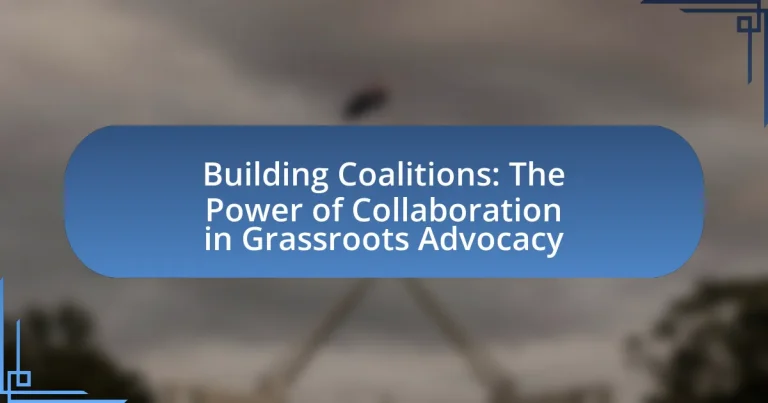The article focuses on the concept of coalitions in grassroots advocacy, highlighting their role as alliances formed by diverse groups to achieve common social change or policy reform goals. It outlines the formation process of coalitions, emphasizing the importance of shared objectives, effective communication, and diverse membership in enhancing advocacy efforts. The article also discusses the advantages of coalitions over individual efforts, including increased resources and community engagement, while identifying key elements for successful coalitions such as strong leadership and mutual trust. Additionally, it addresses strategies for collaboration, conflict resolution, and sustaining coalitions over time, providing practical tips for enhancing coalition-building efforts.

What are Coalitions in Grassroots Advocacy?
Coalitions in grassroots advocacy are alliances formed by diverse groups or individuals who unite to achieve common goals related to social change or policy reform. These coalitions leverage collective resources, knowledge, and influence to amplify their voices and increase their impact on decision-makers. For example, the National Coalition for the Homeless, which includes various organizations and advocates, works together to address homelessness through coordinated efforts, demonstrating the effectiveness of collaboration in driving systemic change.
How do coalitions form in grassroots advocacy?
Coalitions in grassroots advocacy form through the collaboration of diverse groups that share common goals and interests. These groups identify overlapping objectives, which leads to the establishment of partnerships aimed at amplifying their collective voice and influence. Research indicates that successful coalitions often begin with informal discussions among stakeholders, followed by the development of a shared vision and strategic plan, which fosters commitment and resource sharing among members. For instance, the formation of the “Coalition for the Homeless” in New York City in the 1980s exemplifies how various organizations united to address homelessness, demonstrating the effectiveness of collaborative efforts in achieving policy change.
What roles do different organizations play in coalition building?
Different organizations play crucial roles in coalition building by providing resources, expertise, and networks that enhance collective advocacy efforts. Nonprofits often contribute specialized knowledge and grassroots mobilization capabilities, while governmental agencies may offer funding and policy support. Additionally, businesses can bring financial resources and influence, facilitating broader outreach and engagement. Academic institutions contribute research and data analysis, which can inform strategies and strengthen arguments. For instance, the collaboration between environmental organizations and scientific institutions has led to impactful campaigns for climate policy reform, demonstrating how diverse organizational strengths can be leveraged for effective coalition building.
How do shared goals influence coalition formation?
Shared goals significantly influence coalition formation by aligning the interests and motivations of diverse groups, facilitating collaboration. When organizations or individuals identify common objectives, they are more likely to unite their resources and efforts, creating a stronger collective impact. Research indicates that coalitions formed around shared goals can enhance advocacy effectiveness, as seen in the 2018 study by the National Council of Nonprofits, which found that coalitions with clear, shared objectives were 30% more successful in achieving policy changes compared to those without such alignment. This demonstrates that shared goals not only foster unity but also enhance the overall efficacy of grassroots advocacy efforts.
Why are coalitions important in grassroots advocacy?
Coalitions are important in grassroots advocacy because they amplify collective voices and resources, enhancing the effectiveness of advocacy efforts. By uniting diverse groups with shared goals, coalitions can mobilize larger audiences, increase visibility, and exert greater influence on policymakers. For instance, the 2017 Women’s March, which brought together various organizations and individuals advocating for women’s rights, demonstrated how coalitions can create significant social movements that impact legislation and public opinion. This collaborative approach not only strengthens advocacy campaigns but also fosters solidarity among different communities, making it easier to address complex social issues.
What advantages do coalitions provide over individual efforts?
Coalitions provide enhanced resources, collective expertise, and greater influence compared to individual efforts. By pooling resources, coalitions can access funding, manpower, and diverse skill sets that individuals may lack. For instance, a coalition of environmental organizations can mobilize more volunteers and financial support for advocacy campaigns than a single entity could achieve alone. Additionally, coalitions benefit from shared knowledge and strategies, allowing for more effective problem-solving and innovation. Research shows that collaborative efforts often lead to more significant policy changes, as seen in the successful campaigns of coalitions like the Alliance for Climate Protection, which effectively influenced climate legislation through unified advocacy.
How do coalitions enhance community engagement and support?
Coalitions enhance community engagement and support by uniting diverse stakeholders to address common issues collaboratively. This collective approach fosters a sense of ownership among community members, as they actively participate in decision-making processes. Research indicates that coalitions can increase participation rates by up to 50% in community initiatives, as seen in the study “Coalition Building: A Guide for Community-Based Organizations” by the Centers for Disease Control and Prevention. By pooling resources and expertise, coalitions also amplify their impact, leading to more effective advocacy and support for community needs.

What are the Key Elements of Successful Coalitions?
The key elements of successful coalitions include shared goals, effective communication, diverse membership, strong leadership, and mutual trust. Shared goals ensure that all members are aligned in their objectives, which fosters collaboration and commitment. Effective communication facilitates transparency and coordination among members, enhancing the coalition’s ability to respond to challenges. Diverse membership brings various perspectives and resources, enriching the coalition’s strategies and outreach. Strong leadership is crucial for guiding the coalition, making decisions, and motivating members. Lastly, mutual trust among members builds a solid foundation for collaboration, enabling the coalition to function cohesively and effectively. These elements are supported by research indicating that coalitions with these characteristics are more likely to achieve their advocacy objectives and sustain their efforts over time.
How does effective communication contribute to coalition success?
Effective communication is crucial for coalition success as it fosters trust, clarity, and collaboration among diverse stakeholders. When coalition members communicate effectively, they can share goals, align strategies, and address conflicts promptly, which enhances collective decision-making. Research indicates that coalitions with strong communication practices are 25% more likely to achieve their objectives, as evidenced by a study published in the Journal of Community Psychology, which highlights that clear communication reduces misunderstandings and promotes a shared vision. Thus, effective communication directly influences the ability of coalitions to function cohesively and achieve their advocacy goals.
What strategies can be used to improve communication among coalition members?
To improve communication among coalition members, implementing regular meetings and utilizing collaborative technology are effective strategies. Regular meetings foster face-to-face interaction, allowing members to share updates, discuss challenges, and build relationships, which enhances trust and understanding. Collaborative technology, such as shared platforms for document management and communication tools, facilitates real-time information sharing and ensures that all members have access to the same resources and updates. Research indicates that organizations employing structured communication strategies experience increased engagement and productivity, as seen in studies by the Project Management Institute, which found that effective communication can improve project success rates by up to 20%.
How does transparency impact trust within coalitions?
Transparency significantly enhances trust within coalitions by fostering open communication and accountability among members. When coalition partners share information openly, it reduces uncertainty and builds confidence in each other’s intentions and actions. Research indicates that coalitions characterized by high transparency experience stronger relational trust, as members feel more informed and engaged in decision-making processes. For instance, a study published in the Journal of Community Psychology found that transparency in coalition activities led to increased member satisfaction and commitment, ultimately strengthening the coalition’s effectiveness in grassroots advocacy efforts.
What leadership structures are effective in coalitions?
Effective leadership structures in coalitions typically include shared leadership, distributed decision-making, and collaborative governance. Shared leadership allows multiple stakeholders to contribute their expertise, fostering a sense of ownership and commitment among members. Distributed decision-making empowers individuals at various levels to participate in the process, enhancing responsiveness and adaptability. Collaborative governance emphasizes consensus-building and collective problem-solving, which are crucial for addressing diverse interests within the coalition. Research indicates that coalitions with these structures are more successful in achieving their goals, as they leverage the strengths and resources of all members, leading to more innovative and sustainable outcomes.
How can shared leadership models benefit coalition dynamics?
Shared leadership models enhance coalition dynamics by promoting collective decision-making and fostering a sense of ownership among members. This approach encourages diverse perspectives, which can lead to more innovative solutions and increased commitment to coalition goals. Research indicates that coalitions utilizing shared leadership experience improved communication and collaboration, as members feel empowered to contribute their unique skills and insights. For instance, a study by the National Council of Nonprofits highlights that organizations with shared leadership structures report higher levels of engagement and satisfaction among participants, ultimately leading to more effective advocacy outcomes.
What are the challenges of leadership in coalitions?
Leadership in coalitions faces several challenges, including differing agendas among members, communication barriers, and the need for consensus-building. Differing agendas can lead to conflicts, as coalition members may prioritize their own goals over collective objectives. Communication barriers arise from diverse backgrounds and perspectives, making it difficult to convey messages effectively. Additionally, consensus-building is often time-consuming and can stall decision-making processes, hindering the coalition’s ability to act swiftly. These challenges are critical to address for effective coalition leadership and successful advocacy efforts.

What Strategies Enhance Collaboration in Coalitions?
Effective strategies that enhance collaboration in coalitions include establishing clear communication channels, defining shared goals, and fostering trust among members. Clear communication ensures that all coalition members are informed and engaged, which is critical for coordinated efforts. Defining shared goals aligns the coalition’s purpose and motivates members to work together towards common objectives. Fostering trust among members encourages open dialogue and collaboration, which is essential for overcoming challenges and leveraging diverse perspectives. Research indicates that coalitions with strong communication and trust are more likely to achieve their advocacy goals, as evidenced by successful initiatives documented in studies on grassroots movements.
How can coalitions leverage resources for greater impact?
Coalitions can leverage resources for greater impact by pooling financial, human, and informational assets to enhance their collective effectiveness. By combining funding from multiple organizations, coalitions can undertake larger projects that individual members may not afford. For instance, a coalition focused on environmental advocacy can share research data and best practices, leading to more informed strategies and policies. Additionally, coalitions can mobilize volunteers from various member organizations, increasing manpower for campaigns and outreach efforts. This collaborative approach not only amplifies their voice but also maximizes the use of available resources, resulting in a more significant impact on the issues they address.
What types of resources are essential for coalition effectiveness?
Essential resources for coalition effectiveness include human resources, financial resources, informational resources, and organizational resources. Human resources, such as skilled personnel and volunteers, are crucial for executing coalition activities and fostering collaboration. Financial resources provide the necessary funding for initiatives, outreach, and operational costs, which are vital for sustaining coalition efforts. Informational resources, including data, research, and communication tools, enable coalitions to make informed decisions and effectively advocate for their causes. Organizational resources, such as established networks and partnerships, enhance the coalition’s reach and influence, facilitating greater impact in grassroots advocacy. These resources collectively contribute to the overall effectiveness and sustainability of coalitions in achieving their goals.
How can coalitions share resources without compromising their goals?
Coalitions can share resources without compromising their goals by establishing clear agreements that define the scope and limits of resource sharing. These agreements ensure that each member’s objectives are respected while allowing for collaborative efforts. For example, a coalition focused on environmental advocacy may share research data while maintaining individual campaigns that align with their specific missions. This approach is supported by the principle of mutual benefit, where resource sharing enhances collective impact without diluting individual goals.
What role does conflict resolution play in coalition collaboration?
Conflict resolution is essential in coalition collaboration as it facilitates effective communication and fosters trust among diverse stakeholders. By addressing disagreements constructively, coalition members can align their goals and strategies, which enhances overall cooperation. Research indicates that coalitions with strong conflict resolution mechanisms are more likely to achieve their objectives, as they can navigate challenges without damaging relationships. For instance, a study by the National Council of Nonprofits highlights that organizations employing conflict resolution strategies report higher satisfaction and effectiveness in collaborative efforts.
How can coalitions proactively address conflicts among members?
Coalitions can proactively address conflicts among members by establishing clear communication channels and conflict resolution mechanisms. By fostering an environment where open dialogue is encouraged, members can express concerns and grievances before they escalate. Implementing regular meetings and feedback sessions allows for ongoing assessment of group dynamics, enabling early identification of potential conflicts. Additionally, training members in conflict resolution techniques equips them with the skills to handle disputes constructively. Research indicates that coalitions with structured conflict management strategies experience higher levels of member satisfaction and collaboration, as seen in studies conducted by the National Coalition for Dialogue & Deliberation, which highlight the effectiveness of proactive conflict management in collaborative settings.
What techniques are effective for resolving disputes in coalitions?
Effective techniques for resolving disputes in coalitions include negotiation, mediation, and consensus-building. Negotiation allows parties to discuss their differences and reach mutually acceptable solutions, often leading to compromises that satisfy all involved. Mediation involves a neutral third party who facilitates discussions and helps the coalition members communicate more effectively, which can clarify misunderstandings and foster collaboration. Consensus-building focuses on finding common ground among coalition members, encouraging open dialogue and collective decision-making, which strengthens relationships and enhances commitment to shared goals. These techniques are supported by research indicating that collaborative approaches lead to more sustainable resolutions and improved coalition dynamics.
What are best practices for sustaining coalitions over time?
Best practices for sustaining coalitions over time include establishing clear goals, maintaining open communication, and fostering trust among members. Clear goals provide direction and purpose, ensuring that all coalition members are aligned in their efforts. Open communication facilitates transparency and encourages collaboration, allowing members to share ideas and address challenges effectively. Trust among coalition members is crucial, as it strengthens relationships and promotes a sense of shared responsibility. Research indicates that coalitions with strong interpersonal relationships and effective communication strategies are more likely to achieve long-term success and impact in their advocacy efforts.
How can coalitions maintain member engagement and motivation?
Coalitions can maintain member engagement and motivation by fostering open communication, providing opportunities for leadership, and recognizing member contributions. Open communication ensures that all members feel heard and valued, which can enhance their commitment to the coalition’s goals. Providing leadership opportunities allows members to take ownership of initiatives, increasing their investment in the coalition’s success. Recognizing contributions, whether through formal awards or informal acknowledgments, reinforces the importance of each member’s role and encourages ongoing participation. Research indicates that organizations with high levels of member recognition report increased satisfaction and retention rates, demonstrating the effectiveness of these strategies in maintaining engagement and motivation.
What strategies can be implemented to evaluate coalition effectiveness?
To evaluate coalition effectiveness, strategies such as establishing clear goals, measuring outcomes, and conducting regular assessments can be implemented. Clear goals provide a benchmark for success, while measuring outcomes through surveys, interviews, and data analysis allows for quantifiable assessment of coalition impact. Regular assessments, including feedback loops and performance reviews, ensure that the coalition adapts and improves over time. Research indicates that coalitions with defined objectives and systematic evaluation processes are more likely to achieve desired outcomes, as evidenced by studies showing that structured evaluations lead to enhanced collaboration and increased effectiveness in grassroots advocacy efforts.
What practical tips can enhance coalition-building efforts?
To enhance coalition-building efforts, establish clear goals and shared values among participants. This alignment fosters a sense of purpose and commitment, which is essential for effective collaboration. Research indicates that coalitions with defined objectives are more likely to succeed; for instance, a study by the National Network of Partnership Schools found that coalitions with clear goals increased member engagement by 40%. Additionally, regular communication and inclusive decision-making processes strengthen relationships and trust among coalition members, further enhancing collaboration.


